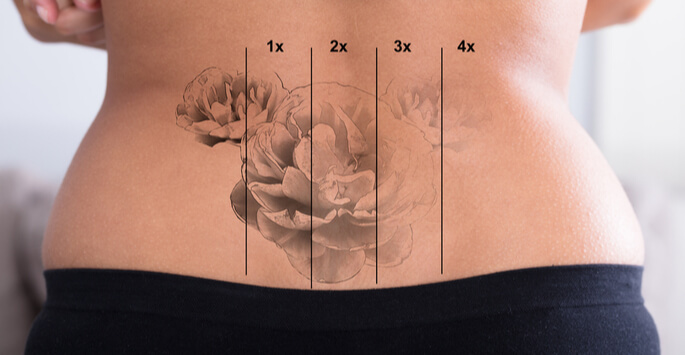“Out Damned Spot”. This line from Shakespeare’s Macbeth reflects the sentiments of many who have tattoos. In fact, a recent study shows that more than 40% of patients with tattoos regret having at least one of them and many would have them removed. Without discussing the social aspects of tattooing, let’s talk about what tattoos are and what can be done about them.
What Is A Tattoo?
Your tattoo, assuming you have one, is considered a “foreign body granuloma” by the dermatology community. It consists of implantations of many different particles in the skin. These particles, consisting of different chemicals which give the tattoo its color, vary in size and depth of implantation. The tattoo particles are engulfed or encapsulated by the body’s healing processes. A thin layer of scar tissue forms around the particles to protect the body from this “invasion”. As a result, with time, tattoos become hazy or less sharp. This is also what makes laser tattoo removal a complex process.
How Does Tattoo Removal Work?
Tattoo removal is a challenge at best. While excision may be the best choice for complete removal, it requires reconstruction and leaves unsightly scars. Previous methods including dermabrasion and peeling of tattoos are passé and minimally effective. The standard for laser tattoo removal has become laser.
In simplified terms, laser light of different wavelengths is used to rapidly heat the tattoo particles breaking them into fragments. The laser disrupts the encapsulation of the tattoo particles and allows the body’s natural healing processes to remove the pigment. While this sounds easy, it is a complex process requiring multiple stages, many variables and a variety of side effects. Variables including, but not limited to, color and depth impact the type of laser used and the necessary parameters. Therefore, laser tattoo removal requires a very versatile laser or lasers to address these issues.
What Should I Know About Laser Removal?
Not all laser tattoo removal are created equal. As previously mentioned, laser tattoo removal is complex due to the many variables. Previously, clinicians would employ multiple lasers to treat tattoos. Often, they would use more than one laser to treat the same tattoo because of multiple colors, depth and other factors. This typically meant more removal sessions, longer sessions, increased discomfort, and side effects such as incomplete removal and “ghosting”. Ghosting is when the tattoo is removed, but a white shadow in the shape of the tattoo is left behind as the natural pigment has been removed from the skin.
When researching and selecting a provider for laser tattoo removal, it is important to understand the type of laser technology they will be using. The latest and most advanced on the market is the PiQo4. The PiQo4 is essentially four laser tattoo removal in one instrument as it uses four laser wavelengths instead of one or two. It combines these multiple wavelengths with both and picosecond (one trillionth of a second) energies for pulse blending or stacking. This allows the laser to penetrate deeper into the skin while still breaking up shallow ink particles making it monanosecond (a billionth of a second)re effective at achieving maximum color clearance. Other features of this advanced tattoo removal laser include a larger spot size for quicker treatments sessions and cooling technology for more comfortable treatment.
Technology advancements such as the PiQo4 mean laser tattoo removal is more effective than ever before. However, that is not to say it’s an easy task. Even if they are unhappy with their tattoo, some may still choose to forgo laser removal. While hindsight is 20/20, a better choice would have been not to have the tattoo done in the first place.
If you are one of the many who is unhappy with your tattoo, check out our Tattoo Removal Orlando, schedule a free consultation with The Institute of Aesthetic Surgery by calling (407) 409-8000. Lady Macbeth’s exclamation – “Out Damned Spot” seems amazingly appropriate.


